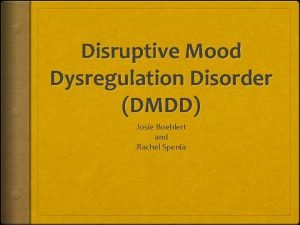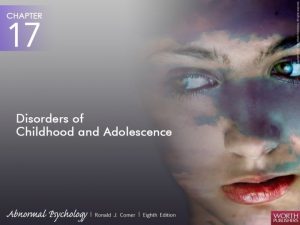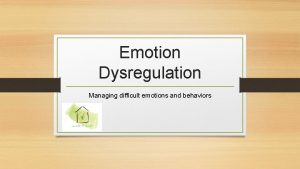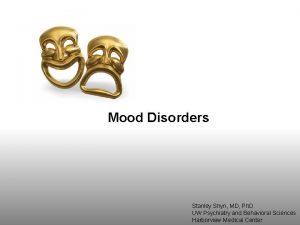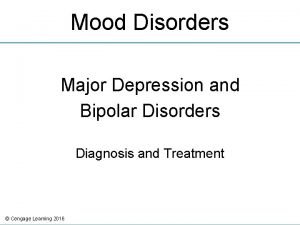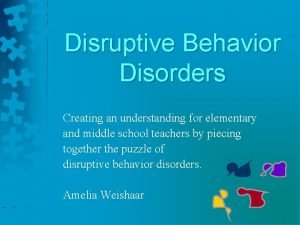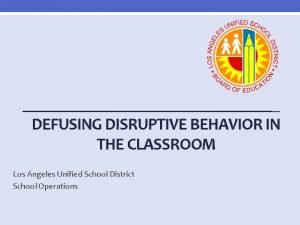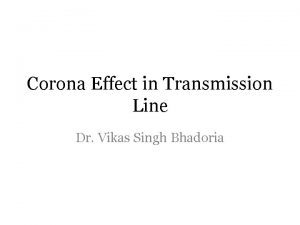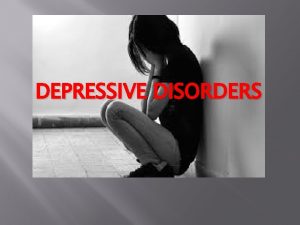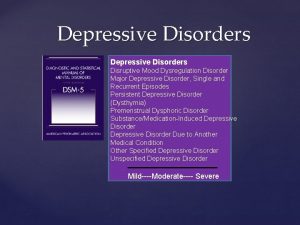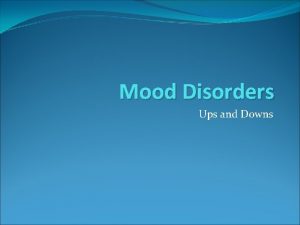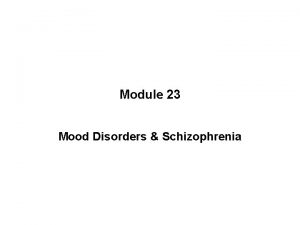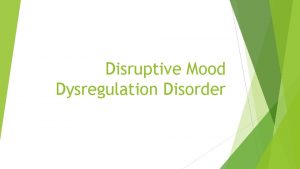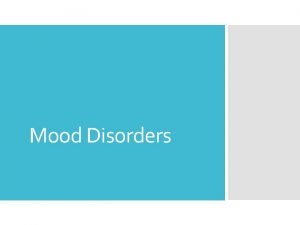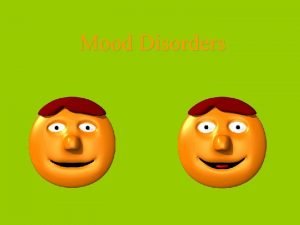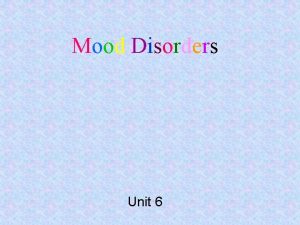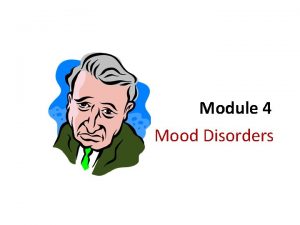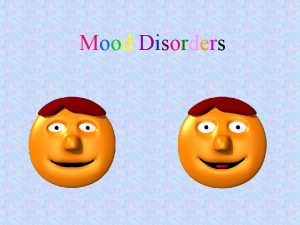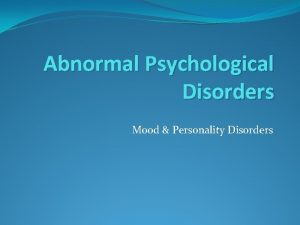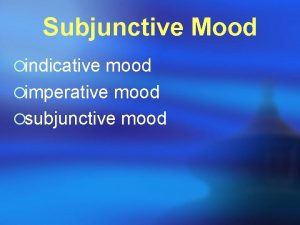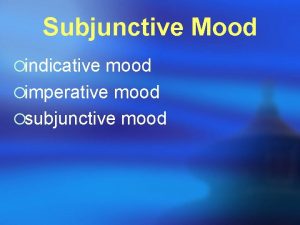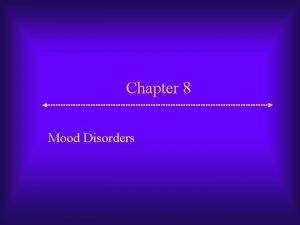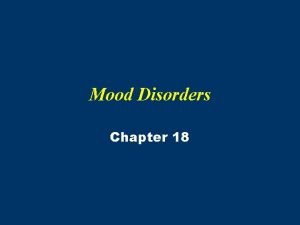MOOD DISORDERS Chapter E 3 DISRUPTIVE MOOD DYSREGULATION

















- Slides: 17

MOOD DISORDERS Chapter E 3 DISRUPTIVE MOOD DYSREGULATION DISORDER Florian Daniel Zepf, Caroline Sarah Biskup, Martin Holtmann, & Kevin Runions TS Companion Powerpoint Presentation Adapted by Julie Chilton

The “IACAPAP Textbook of Child and Adolescent Mental Health” is available at the IACAPAP website http: //iacapap. org/iacapap-textbook-of-child-and-adolescentmental-health Please note that this book and its companion Power. Point are: · Free and no registration is required to read or download it · This is an open-access publication under the Creative Commons Attribution Noncommercial License. According to this, use, distribution and reproduction in any medium are allowed without prior permission provided the original work is properly cited and the use is non-commercial.

Disruptive Mood Dysregulation Disorder Outline • Clinical Presentation & Diagnosis • Epidemiology • Course and Outcome • Assessment & Differential Diagnosis • Etiology & Risk Factors • Treatment

Disruptive Mood Dysregulation Disorder Introduction “DMDD” Temper outbursts with chronic irritability New, controversial diagnosis in DSM-5 Introduced to address pediatric bipolar disorder controversy Other interpretations: • Severe Mood Dysregulation (SMD), Leibenluft, 2003, minus hyperarousal • Child Behavior Checklist Dysregulation Profile • DMDD vs ADHD vs Oppositional Defiant DIsorder vs Bipolar Disorder • Distinct etiology • Different neurobiology • Divergent developmental outcomes • All 4 have irritability and temper outbursts • Debate about clinical validity and usefulness • • •


Disruptive Mood Dysregulation Disorder Severe Mood Dysregulation • “SMD” described by Ellen Leibenluft et al in 2003 • Chronic (non-episodic) and severe irritability and hyperarousal without euphoria and grandiosity of bipolar disorder • More studies on SMD than DMDD • Upper age limit of onset for diagnosis of SMD is 12 vs 10 in DMDD • SMD diagnosis requires symptoms of hyperarousal , DMDD does not • Increased risk for later depressive and anxiety disorders in adulthood but not bipolar disorder

Disruptive Mood Dysregulation Disorder Child Behavior Checklist Dysregulation Profile • Captures broad overlap between SMD and DMDD behaviors • Severe behavioral and affective dysregulation: • Irritability, aggression • Mood instability and “affective storms” • Hyperarousal • Extreme scores on CBCL syndrome scales: • “anxious/depressed” • “attention problems” • “aggressive behavior” • Epidemiology: • 1 -2% in epidemiological samples from multiple studies • 6 -7% in child psychiatric clinical samples (Holtman et al, 2008) • 13 -20% in children with ADHD (Holtman et al, 2008) • Increased risk for later substance use, conduct and mood disorders, suicidal ideation and attempts, but not for bipolar disorder

Disruptive Mood Dysregulation Disorder Epidemiology • 97% of SMD youths met criteria for DMDD, remainder failed to meet criteria only due to age of onset • 8% 3 -month DMDD prevalence in 6 -year-old American children (Dougherty et al, 2014) • Only 1% preschool and school age cohorts qualified when duration and frequency criterion applied (Copeland et al, 2013)

Disruptive Mood Dysregulation Disorder Course and Outcome • 80% children with DMDD at age 9 also met criteria at age 6 • Childhood DMDD diagnosis has increased risk of: • Depressive disorders and ADHD • Disruptive behavior disorder symptoms • Peer relationship problems • Peer exclusion and victimization • Relational aggression • Adolescent DMDD diagnosis has increased risk of: • Serious illness • Sexually transmitted diseases • Other non-substance related psychiatric disorders • Nicotine use • Police contact • Poverty • Not achieving a high school diploma and no college attendance • Patients with DMDD or SMD do not show later increased risk for bipolar but do have an increased risk for depressive disorders

Disruptive Mood Dysregulation Disorder Assessment & Differential Diagnosis • Irritability and temper outbursts common to DMDD, ADHD, oppositional defiant disorder, conduct disorder, bipolar • Overdiagnosis of bipolar disorder between 1993 -2003 in US • Doubled in adults • Increased 40 times in people under 20 • General consensus: bipolar diagnosis requires distinct manic or hypomanic episodes



Disruptive Mood Dysregulation Disorder Etiology & Risk Factors Developmental predictors of DMDD at age 6 (Dougherty et al, 2014): • Parental lifetime substance use • Temperamental “surgency” • High levels of activity • Reward seeking • Low shyness • Impulsivity Chart review showing ¾ of DMDD patients had parents with mental health issues: • Major depressive disorders • ADHD • Anxiety disorders

Disruptive Mood Dysregulation Disorder Social-Affective and Cognitive Neuroscience In SMD and bipolar disorder vs healthy controls: • Less accuracy in labelling expressions • Less sensitivity in facial emotion recognition • Biased processing of threatening faces (Hommer et al 2014) Differential neural activation on FMRI of patients with SMD shown fearful faces: • Posterior cingulate cortex • Posterior insula • Inferior parietal lobe (Thomas et al, 2013)

Disruptive Mood Dysregulation Disorder Treatment • Few trials to inform clinical practice • Most recommendations from studies with SMD, ODD and depression • Younger children with emotion dysregulation more sensitive to changed parenting than children without • Possible off-label psychopharmacological options: stimulants (methylphenidate), antidepressants, antipsychotics (risperdal), mood stabilizers (divalproex) • Psychoeducation • Collaboration with teachers • Strategies for dealing with crises • Identification of potential stressors and triggers • Parenting programs • Family therapy *rule out abuse and neglect

Disruptive Mood Dysregulation Disorder Conclusion: Key Messages • Useful diagnosis for children with severe, nonepisodic irritability • Irritability likely related to the depression dimension • Different from bipolar disorder in longitudinal course, family history, and neuropsychological performance • Diagnose pediatric bipolar disorder only when discrete episodes of mania • Limited evidence to guide treatment

Disruptive Mood Dysregulation Disorder T hank You!
 Dysregulatory mood disorder
Dysregulatory mood disorder Dmdd medication
Dmdd medication Mood dysregulation disorder
Mood dysregulation disorder Emotional dysregulation
Emotional dysregulation Bdt emotional dysregulation
Bdt emotional dysregulation Mood disorders
Mood disorders Example of stabilizing selection
Example of stabilizing selection Distributive justice
Distributive justice Disruptive behavior disorder nos
Disruptive behavior disorder nos Disruptive agricultural technology
Disruptive agricultural technology Cloud computing disruptive technology
Cloud computing disruptive technology Disruptive coloration
Disruptive coloration Social media disruptive technology
Social media disruptive technology Defusing disruptive behavior in the classroom
Defusing disruptive behavior in the classroom Disruptive
Disruptive Theory of corona formation
Theory of corona formation Disruptive technology in the past
Disruptive technology in the past Eee4123
Eee4123

